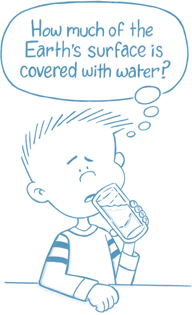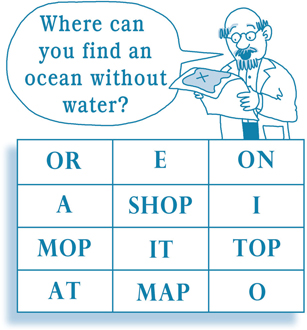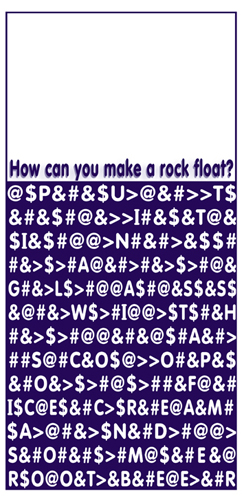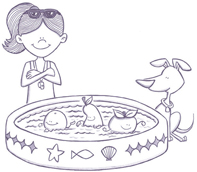Everything Kids' Magical Science Experiments Book (8 page)
Read Everything Kids' Magical Science Experiments Book Online
Authors: Tim Robinson
Tags: #epub, ebook

- Was there a difference in the results between placing a light ball on top of a heavy ball and placing a heavy ball on top of a light ball? Why do you think this difference exists?

- In looking at your results, which factor do you think has the biggest impact on the bounce height: the weight of the ball or the material the ball is made of?

- Do you think it's important that the balls be round? What might happen if you were to use a ball with a different shape?

- Can you think of any applications for this idea that you could use in real life?

Your choice of balls and the order in which you placed them were both important decisions. Larger balls tend to have more energy, but they also weigh more. However, when their large energy is transferred to a much lighter ball, that energy goes a long way in making the smaller ball bounce. Can you imagine the effect if you were to try this experiment with three balls? What about four or more? It might be hard to keep them all balanced, but imagine the show you could put on!

Kinetic energy:
Energy that an object possesses due to its motion.
Water, Water, Everywhere

D
id you know that approximately 70 percent of Earth's surface is covered in water? And yet, less than one-tenth of one percent of all that water is drinkable. In fact, if you were to fill a gallon jug of water, and thought of that gallon as being all the world's water, less than one teaspoon of that water would be drinkable. Water is a precious commodity in our world, and it also provides a great starting place for seeing some amazing science take place.
In this chapter, you will get to explore the mysterious nature of water, and see some of its magical characteristics. You'll float paper clips, conjure up a magical water genie, make water disappear, and watch water change color.

There's nothing worse than opening up a bottle of water, starting to drink, and finding a hole in the side that has caused the water to spill out onto your face and shirt. Luckily, most water bottles, though made of plastic, don't have holes in them, so you can enjoy the water inside without worry about a leak. However, in this experiment you'll see how you can actually poke holes in a plastic container without the water spilling out.
Question: When does a hole not leak?
- Plastic bag, preferably the kind found in produce sections at the grocery store
- Sharpened pencil
- Rubber band or twist-tie
- Water
- Shallow baking pan
- To begin, fill the plastic bag with water until it is at least half full. Make sure there are no holes in the bag.
- Tie off the top of the bag so there is still some air left between the water and the top of the bag.
- Carefully poke the pencil through the bag so it goes in one side of the bag and out the other.
- Set the bag in the pan and look for any leaks.
Use the directions to cross words out of the grid. When you are finished, read the remaining words from top to bottom and left to right. As if by magic, you will find the answer to this silly science riddle!
Cross out all theâ¦
â¦two-letter words without N
â¦5th, 9th, and 15th letters
â¦words that rhyme with HOP

This experiment demonstrates as much about the properties of plastic as it does about water. You see, plastic is made from polymers, which are molecules that are chained together. These polymers give plastic its strength. In the case of plastic bags from the produce department, the polymers that are used actually shrink when cut. As a result, when you poked the pencil through the side of the bag, the plastic molecules shrank, and acted as a seal around the pencil. This is what kept the water from leaking.
Can you think of a place where this sort of behavior could be useful? Where might someone want to have a material that reacts to a puncture by closing down and forming a seal?
One place this technology is being used is in automobile tires. Some new tires react to a puncture by forming an automatic seal over the hole. In some cases this is done by releasing a filler material inside the tire, but in others, the material the tire is made out of simply shrinks and seals the hole, at least until the owner can get to a repair shop.
Question: Does metal float?
- A cup of tap water
- Paper clips
- Liquid dish soap or a bar of soap
- Bend one paper clip into a flat hook shape, so a second paper clip can be placed on the flat surface.
- Try to place a paper clip on the surface of the water so that it does not sink.
- Carefully place a second paper clip on the flat part of the unfolded paper clip and slowly lower it into the water. The paper clip should float.
- Place a few drops of soap in the water, or touch the bar of soap to the water's surface and watch what happens to the paper clip.
The paper clip floats because of the surface tension of the water. If you were to place the paper clip in the water at an angle or drop it from a height, the force would break the surface tension and it would sink. But gently lowering the paper clip onto the water allows the surface tension to stay intact and the paper clip floats. Adding the soap breaks the tension and the paper clip sinks to the bottom of the glass.

More than 80 billion gallons of water are wasted each year in America by people waiting for water from their faucets to get warm.

“Water is H2O, hydrogen two parts, oxygen one, but there is also a third thing, that makes it water and nobody knows what that is.”
â
D. H. Lawrence, British novelist
You can extend this experiment by testing different objects, such as a needle or a small nail to see which ones float and which do not. Try to find out what shapes, sizes, and weights seem to work the best. Does soap always cause these other items to sink?
SURFACE TENSION:
A result of water molecules squeezing together to produce a sort of lid on the surface of the water.

It's trueâmetal does float!Large ships are often made out of steel or other kinds of metal and they float due to their shape. If a ship's metal was made into a ball of metal, it would sink, but because of its shape, it easily floats in water.
Is it magic? Is it science? Or is it just silly?! To find the answer to this riddle, use a bright colored marker to highlight all the letters in the puzzle grid. Ignore the symbols, dollar signs, etc. Read the letters from left to right, and top to bottom.

Question: What makes an orange float or sink in water?
KIDS' LAB LESSONS

When first exploring water, many children wear water wings, life jackets, or other aids to help them stay afloat. But what does a piece of fruit wear in the water if it wants to keep from sinking? In this experiment, you will place fruits in water with and without their peels and decide which peels help keep their fruits high and dry.